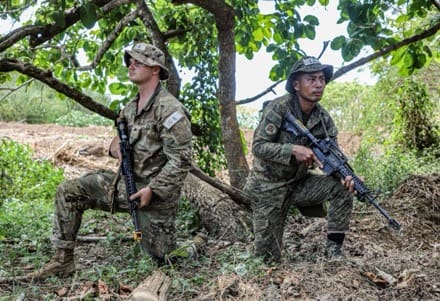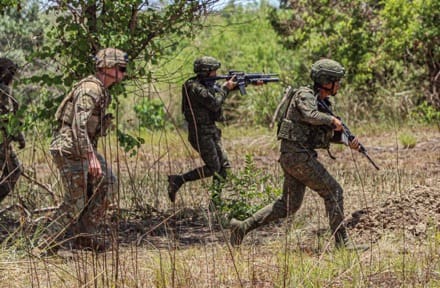WASHINGTON — The ability to quickly put cutting-edge warfighting equipment in the hands of Soldiers is key to maintaining readiness, says 25th Infantry Division commander, Maj. Gen. Marcus Evans
Incorporating new technology like drones allows Soldiers to become familiar with off-the-shelf equipment that can increase protection and lethality, he added.
Evans spoke during a media roundtable appearance Friday to highlight participation in “Transform in Contact” efforts in the Philippines during Balikatan, an annual bilateral training exercise that supports the U.S.-Philippine Mutual Defense Treaty.
“Transformation in Contact” is the first step in the Army’s continuous plan to deliver new technologies to deployed warfighters for testing and analysis. In the 25th Infantry Division, 2nd Brigade is spearheading that effort.
“The broad framework that drives our overall assessment validation is, are we more lethal? Are we more mobile? Can we enable infantry formations, combat formation, sustainment formations to see further, to have better sensing capability, to be able to strike further with organic assets” while protecting the force, he said.
Evans said the division’s participation not only helps integrate emerging technologies into warfighting but helps leaders up and down the chain of command to develop solutions to constantly changing combat developments.
“Our main focus is on warfighting readiness,” he said.
The use of unmanned aircraft systems allows the Army the ability to see further, to have better sensing mechanisms, better striking mechanisms, and then to be able to project force while protecting the force, he said.
“Now we have small, unmanned air system in the hands of squad leaders that can see three to five kilometers from their current position, which allows them to understand the battlefield better, protect themselves, and creates increased lethality,” Evans said.
Also key is countering drone threats, “and how we can sense those threats that are approaching a formation, and then take actions to protect the formation or to interdict those elements … that are trying to strike us,” he said.
Lessons learned from the Philippine training will be incorporated into the next Combat Training Center rotation in Hawaii at the Joint Pacific Multinational Readiness Center [JPMRC].
That October training will involve wide-ranging joint participation, he said, particularly from the Air Force and Navy.
“From a multinational perspective, we are planning to incorporate about a battalion-sized force from Japan,” he said, as well as fire assets from Singapore and Thailand, and logistics teams from Malaysia.
The shoulder-to-shoulder training in the Philippines really starts at JPMRC, Division Command Sgt. Maj. Shaun Curry said.
“A young American kid joins the service, [goes] to Hawaii for their first duty location, and they go to JPMRC, where they meet a host of our multinational partners for the first time. We’re starting our partnerships in on-the-ground friendships, and we start training inside of the jungle … From there, those partnerships and friendships grow into our operations, pathways rotations, whether that’s the Philippines, Malaysia, Indonesia, and we’re really growing as the transformation in contact happens, helping them see their own formations, how they fight, and how they utilize technology.”
Curry said Soldiers learned from Filipino partners that carrying less on a march is far better, given the terrain, heat and humidity. Likewise, Soldiers are fielding newer body armor that weighs 20% less than older equipment, which improves their ability to move through the jungle.
Troops are also incorporating unique methods to use powered, load-carrying vehicles, similar to the common wheelbarrow, Curry said. The new approach enables one Soldier to load several hundred pounds, whether it be causalities or mortars, and move across restricted terrain. Where once it would take a squad to move a third of the weight, the soldier can now execute the mission solo and faster, allowing the remainder of the squad to focus on elements of lethality or protection, he said.
Evans said the Philippine training also confirmed that the time it takes to place equipment on the field is compressing.
“From the time period that we were asked to start executing this transformation in contact, it was the shortest amount of time that I have ever experienced having equipment show up,” he said.
By Jonathan Austin, Army News Service



